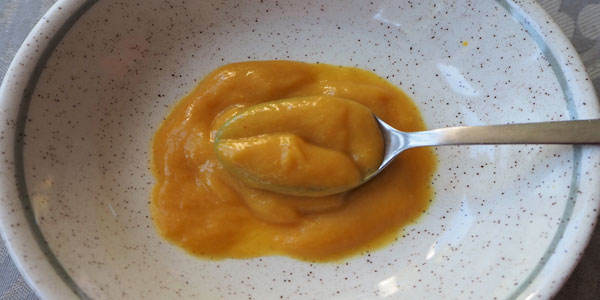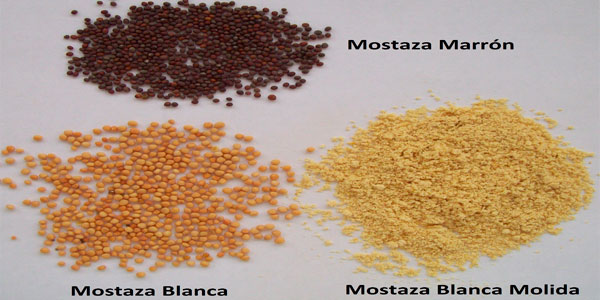Write: Tomás Franco. Author of Manual for Spices
The main use of mustard seeds is to make mustard sauce. From it we can find hundreds of formulas. Take as an example some of the most famous, listed below.
- English mustard, with white and brown seeds, flour and turmeric.
- French from Dijon, with ground husked brown mustard seeds and wort, ideal for sauces and mayonnaise.
- French Bordeaux, with whole seeds, vinegar, sugar and tarragon, ideal for cold cuts.
- Agreement, similar to that of Bordeaux, but flavored with spices, herbs and caramel, ideal for cold cuts and sausages.
- Americana , with powdered white seeds, flour, vinegar and turmeric, ideal for hot dogs and hamburgers.
- Italian from Cremona, prepared with fruits.

At this point, it is necessary to explain how many types of mustard seeds there are. Three types of seeds are produced (all belonging to the botanical family "Brassicaceae ”).
- White mustard (White mustard) "Sinapis alba L."
- Brown (Brown mustard) "Brassica juncea L."
- Black (Black mustard) "Brassica nigra L."

White mustard is the most common, light yellow in color (sometimes called yellow mustard), large in size and mild in flavor.
For its part, the brown is smaller, with an intense flavor and a dark brown color.
By contrast, black is grown locally and rarely found in western markets.
No mustard seed has an aroma and its flavor is mild and delicate at first. Afterwards, it reaches a bitter and spicy flavor, more intense in the brown type.
Nutritional composition
| Energy (kJ / 100 g) | 2262 |
| Energy (kcal / 100 g) | 543 |
| Carbohydrates (g / 100 g) | 27,4 |
| Sugars (g / 100 g) | 6,8 |
| Total fat (g / 100 g) | 36,0 |
| Saturated fat (g / 100 g) | 2,0 |
| Monounsaturated fat (g / 100 g) | 22,5 |
| Polyunsaturated fat (g / 100 g) | 10,1 |
| Proteins (g / 100 g) | 27,3 |
| MINERALS | |
| Calcium (Ca) (mg / 100 g) | 338 |
| Copper (Cu) (mg / 100 g) | 0,6 |
| Phosphorus (P) (mg / 100 g) | 820 |
| Iron (Fe) (mg / 100 g) | 9 |
| Magnesium (Mg) (mg / 100 g) | 370 |
| Manganese (Mn) (mg / 100 g) | 2 |
| Potassium (K) (mg / 100 g) | 715 |
| Selenium (Se) (mg / 100 g) | 0,2 |
| Sodium (Na) (mg / 100 g) | 10 |
| Zinc (Zn) (mg / 100 g) | 6 |
| VITAMINS | |
| Vit. A (retinol) (IU / 100 g) | 31 |
| Vit. B1 (thiamine) (mg / 100 g) | 0,7 |
| Vit. B2 (riboflavin) (mg / 100 g) | 0,3 |
| Vit. B3 (niacin) (mg / 100g) | 6,5 |
| Vit. B5 (pantothenic acid) (mg / 100 g) | 0,8 |
| Vit. B6 (pyridoxine) (mg / 100 g) | 0,4 |
| Vit. B9 (folic acid) (μg / 100 g) | 162 |
| Vit. C (ascorbic acid) (mg / 100 g) | 12,1 |
| Vit. E (tocopherol) (mg / 100 g) | 12,4 |
| Vit. K (μg / 100 g) | 5,4 |
Properties and contributions of mustard
It has a high caloric index, mainly due to its oil content, very rich in mono and polyunsaturated fats. It is the spice with the highest protein content and its carbohydrate content is one of the lowest.
It is worth noting the content of phosphorus, magnesium and manganese. As well as the content of vitamin E and the presence of pantothenic acid.
Now let's use mustard seeds in our kitchen to season veggies, vegetable salads, stews, stews, and marinades. Of course, also to make a rich MUSTARD MAYONNAISE. Here is the recipe.
Ingredients:
- 1 egg yolk
- ½ teaspoon ground mustard
- ½ teaspoon Worcestershire sauce
- 5 ml of white wine
- shawl
- ground white pepper
- Tabasco sauce
- 250 ml of sunflower oil
- The juice of half a lemon
Preparation:
- Mix the egg yolk with the mustard, Worcestershire sauce, white wine, salt, ground white pepper and 3 drops of Tabasco.
- Add slowly while gently mixing the sunflower oil.
- Finally add the lemon juice while continuing to mix.
- This sauce is ideal for dressing salads.






